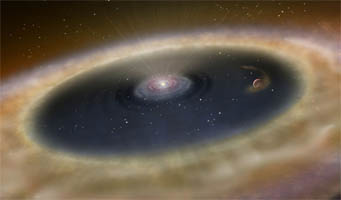Given the opportunity to start my astronomical career all over again, I'd jump at the chance to search for planets around stars beyond our solar system. Efforts to discover and study these exoplanets have really mushroomed in the past decade — so much so that the census of confirmed finds plus Kepler's candidates now tops 2,000.

An artist’s conception of the region near the now-forming exoplanet LkCa 15 b.
Karen L. Teramura / UH-IfA
So many alien worlds are now known that it's no longer "breaking news" when new ones are discovered. But this week's announcements about two interesting systems caught my attention, so here's a recap of each.
First comes word from the University of Hawaii's Institute for Astronomy that two astronomers have recorded a planet in the making. Adam Kraus (UH-IFA) and Michael Ireland (Macquarie University and Australian Astronomical Observatory) observed a star designated LkCa 15 using the Keck II telescope in November 2009, August 2010, and November 2010. Located about 450 light-years away in the Taurus-Auriga star-forming region, LkCa 15 was already known to be encircled by a massive dust disk with a big gap in it.
Kraus and Ireland using Keck's adaptive-optics system, along with a special mask that allowed light to reach the detector only from several holes spread across the giant telescope's mirror. This technique, called aperture mask interferometry made it easier to get the sharpest possible images of LkCa 15's dusty disk and see detail as close to the star as possible. They also observed at near-infrared wavelengths to make details in the dusty disk stand out more clearly.

Three infrared images, acquired with the Keck II telescope at a wavelength of 3.5 microns, show the development of a forming exoplanet designated LkCa 15 b. A plus sign marks the location of its parent star, and the image is 0.5 arcsecond wide.
Kelly Beatty
What the two researchers found, to their surprise, was a distinct blob of material — a just-forming planet — circling within the clearing. "LkCa 15 b is the youngest planet ever found, about five times younger than the previous record holder," notes Kraus in a press release. "This young gas giant is being built out of the dust and gas."
As Kraus and Ireland detail in a report to appear in the Astrophysical Journal, LkCa 15 is just one of 150 young dusty stars being studied with Keck's powerful optics.
The second tidbit concerns newly released images of a white-dwarf star with an orbiting companion. Actual images of exoplanets are themselves rare. But in the infrared views acquired by NASA's Spitzer Space Telescope, WD 0806-661 and its companion are separated by a whopping 130 arcseconds. That corresponds to 2,500 astronomical units (230 billion miles) at the star's distance of 63 light-years.

Infrared images taken by the Spitzer Space Telescope in 2004 and 2009 show a faint object moving through space together with a white dwarf designated WD 0806-661. Theirs separation is 130 arcseconds, corresponding to about 2,500 astronomical units. The companion, considered a brown dwarf, is the coldest companion object to be directly imaged outside our solar system.
K. Luhman & others
This is the kind of wide separation more akin to binary stars than planetary systems. But the companion, designated WD 0806-661 b, is not a star because it's far too dim in the Spitzer views. Instead, argue Kevin Luhman (Penn State) and two colleagues, it must have a very cool surface, somewhere between 80° and 160° Fahrenheit (30° and 70° Celsius).
Luhman, joined by Adam Burgasser (University of California, San Diego) and John Bochanski (Penn State), spotted WD 0806-661 b moving in tandem with the white dwarf WD 0806-661 in Spitzer images taken in 2004 and 2009. But when they tried to record its spectrum last December with the 6.5-m Magellan Telescope, they got nada. It was too dim and cold to be detected.
As detailed in a forthcoming issue of the Astrophysical Journal, the three researchers estimate that WD 0806-661 b has a mass of just 6 to 9 times that of Jupiter. So is it a lukewarm superplanet or the coolest known brown dwarf? They call it the latter in their paper and in this press release, but they'd get an argument from exoplanet specialists. Clearly this object is making the distinction between failed stars and supersize planets much fuzzier.
 2
2
Comments
Anthony Barreiro
October 21, 2011 at 12:56 pm
Yes, these are very interesting findings. Somehow everything we're learning about other stars and their planets gives me hope that we may learn to take better care of our own planet. The fact that the brown dwarf people and the exoplanet people are starting to argue about bodies that are intermediate between small brown dwarfs and large planets simply means that our methods are getting more refined. This reminds me of old arguments between biochemists and molecular biologists.
You must be logged in to post a comment.
Anthony Barreiro
October 21, 2011 at 12:56 pm
Yes, these are very interesting findings. Somehow everything we're learning about other stars and their planets gives me hope that we may learn to take better care of our own planet. The fact that the brown dwarf people and the exoplanet people are starting to argue about bodies that are intermediate between small brown dwarfs and large planets simply means that our methods are getting more refined. This reminds me of old arguments between biochemists and molecular biologists.
You must be logged in to post a comment.
You must be logged in to post a comment.